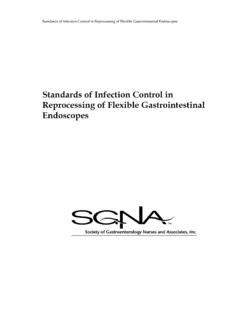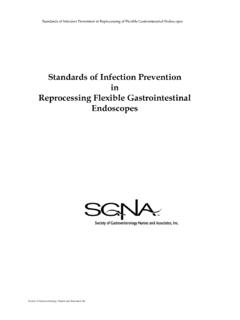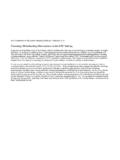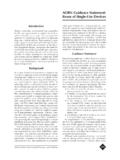Transcription of Automated endoscope reprocessors - ASC Quality
1 STATUS EVALUATION REPORTA utomated endoscope reprocessorsPrepared by: ASGE TECHNOLOGY COMMITTEEM ansour A. Parsi, MD, MPH, FASGE, Shelby A. Sullivan, MD, Adam Goodman, MD, FASGE,Michael Manfredi, MD, Udayakumar Navaneethan, MD, FASGE, Rahul Pannala, MD, MPH,Zachary L. Smith, DO, Nirav Thosani, MD, Subhas Banerjee, MD, FASGE, previous Committee Chair,John T. Maple, DO, FASGE, ChairThis document was reviewed and approved by the Governing Board of the American Society for GastrointestinalEndoscopy (ASGE).The ASGE Technology Committee provides reviews ofexisting, new, or emerging endoscopic technologies thathave an impact on the practice of GI methodology is used, with a MEDLINE literature search to identify pertinent clinical studieson the topic and a MAUDE ( Food and Drug Admin-istration [FDA] Center for Devices and RadiologicalHealth) database search to identify the reported compli-cations of a given technology.
2 Both are supplementedby accessing the related articles feature of PubMedand by scrutinizing pertinent references cited by theidentified studies. Controlled clinical trials are empha-sized, but in many cases data from randomized,controlled trials are lacking. In such instances largecase series, preliminary clinical studies, and expertopinions are used. Technical data are gathered fromtraditional and Web-based publications, proprietarypublications, and informal communications with perti-nent Status Evaluation Reports are drafted by 1or 2 members of the ASGE Technology Committee, re-viewed and edited by the committee as a whole, andapproved by the Governing Board of the ASGE. Whenfinancial guidance is indicated, the most recent codingdata and list prices at the time of publication are pro-vided. For this review the MEDLINE database wassearched through February 2016 for articles related toautomated endoscope reprocessors (AERs), using thewords endoscope reprocessing, endoscope cleaning, Automated endoscope reprocessors , and high-leveldisinfection (HLD).
3 Technology Status Evaluation Reports are scientificreviews provided solely for educational and informa-tional purposes. Technology Status Evaluation Reportsare not rules and should not be construed as establishinga legal standard of care or as encouraging, advocating,requiring, or discouraging any particular treatment orpayment for such 20 million GI endoscopic procedures areperformed annually in the United ofinfectious agents by endoscopes is considered to beextremely rare, occurring with an estimated frequency of1 in million , this infection ratemay be an underestimate because of incompletesurveillance, under-reporting, asymptomatic infections,and infections with a long incubation endoscopes are semicritical medical devicesand require at least HLD after each istraditionally defined as complete elimination of allmicroorganisms in or on an instrument, except forsmall numbers of bacterial is operationallydefined by the FDA as a 6-log reduction of minimize the risk of transmission of infectiousagents, standardized guidelines have been developedfor the reprocessing of FDA definesreprocessing as validatedprocesses used to render acontaminated medical offlexible GI endoscopes is a multistageprocess (Table 1) that begins immediately aftercompletion of an endoscopic procedure.
4 The initial stepis in-room or bedside precleaning and aspiration of adetergent solution through the suction channel. This isfollowed by leak testing and then by thorough manualcleaning, with washing and brushing of accessiblechannels. Subsequently, HLD is performed via immersionfor an appropriate duration of time in a liquid chemicalgermicide of appropriate concentration, followed by awater rinse, alcoholflush, and air drying of allCopyright 2016 by the American Society for Gastrointestinal Endoscopy0016-5107/$ 84, No. 6 : 2016 GASTROINTESTINAL ENDOSCOPY885endoscope ,9-11 Although all endoscope reproc-essing steps can be performed manually, automation ofsome steps has been shown to be advantageous, is sup-ported by available evidence, and is recommended bysome ,13,14 TECHNICAL CONSIDERATIONSAERs are machines designed for the cleaning and HLDof heat-sensitive replace some of themanual steps involved in endoscope reprocessing(Table 1).
5 Early AERs were designed to replace only theHLD step of endoscope reprocessing, but over timeadditional functions have been added. The FDAclassifies AERs as medical devices that require 510(k) ,15 FDA-approved AERs available for use inthe United States are listed inTable must undergo thorough manual cleaningbefore placement within an AER. AERs have basins to allowendoscopes to be submerged and bathed in the HLD solu-tion. The endoscope channels are attached to the AERusing special connectors, which allow circulation of HLDsolution under pressure through the channels, thusexposing interior channels and outside surfaces of theendoscope to the HLD solution. The AER circulates theHLD solution continuously during the exposure periodor cycle time, which typically varies from 22 to 30 completion of the HLD cycle, AERs automaticallyrinse the reprocessed endoscope with water to removetoxic HLD solution residues.
6 Some AERs thenflush theendoscope channels with forced air or with 70% to 80%ethyl or isopropyl alcohol followed by forced air to aid indrying the endoscope channels to prevent growth of water-borne pathogenic microorganisms during AERreprocessing is interrupted at any point, HLD of the devicecannot be ensured, and the entire process should ,11 AERs offer several advantages over manual automate and standardize several importantreprocessing steps, thereby eliminating the possibility ofmissed steps because of human error, and minimize expo-sure of endoscopy or sterile processing departmentpersonnel to HLDs or chemical ,16-19A prospec-tive study evaluating the impact of human factors and auto-mation on endoscope reprocessing indicated that use ofAERs was associated with increased consistency andcompliance with endoscope reprocessing guidelines andinversely associated with skipped steps during , use of AERs reduced a number ofhealth problems attributed to reprocessing amongpersonnel involved in a result of automationof several reprocessing steps, AERs also reduce work-related repetitive movements that can potentially causebodily ,14 HLD solutions are germicides that eliminate all micro-organisms except bacterial solutions canact as sterilants if an increased exposure time ,20,21 However, the exposure time required toachieve sterilization with most HLD solutions is far longerTABLE 1.
7 endoscope reprocessing steps*StepPurposeCan be performed byAER (also seeTable 2)Precleaning Begins in the procedure room immediately after procedure and before disconnectingthe endoscope from the power source Precleaning removes bioburden before it has an opportunity to dry NoLeak testing Detects damage to the interior or exterior of the endoscope Leak testing is done before immersion of the endoscope in reprocessing solutionsto minimize damage to parts of the endoscope not designed forfluid exposure YesManual cleaning Ensures removal of retained bioburden Retained bioburden may inactivate or interfere with the capability of the HLD solutionto effectively kill or inactivate microorganisms No*Rinse after cleaning Removes residual debris and detergent YesVisual inspection Ensures the endoscope is visually clean before proceeding to HLD Manual cleaning and rinse after cleaning should be repeated if visual inspection fails NoHLD Destroys all viable microorganisms but not necessarily
8 All bacterial spores YesRinse after HLD Prevents exposure and potential injury of skin and mucous membranesfrom chemical residue YesDrying Prevents growth of waterborne pathogens YesAER, Automated endoscope reprocessor;HLD, high-level disinfection.*Manual cleaning is required even when AER manufacturers claim that manual cleaning is ,42 Automated endoscope reprocessors886 GASTROINTESTINAL ENDOSCOPYV olume 84, No. 6 : is practical, and therefore these formulations areonly used for ,22 HLD solutions cleared by theFDA include those formulated with glutaraldehyde, or-thophthalaldehyde, peracetic acid, chlorine, andhydrogen formulations containcombinations of microbicidal agents, including peraceticacid and hydrogen peroxide, glutaraldehyde andphenol/phenate, and glutaraldehyde and FDA periodically updates a list ofapproved HLD solutions along with some of theirattributes such as contact time and temperaturerequired for approved HLD solutionsare listed inTable AER manufacturers specify the type of HLD solu-tion to be used in their machines, often on a proprietarybasis (Table 2).
9 It is important to comply with AERmanufacturers instructions. Some HLD solutions areeffective only at elevated temperatures. AERs that usesuch solutions have reservoirs with heating elementsthat increase the temperature of the HLD solution tothe appropriate ,11 Some AERs use HLD solutionsthat are reusable for 5 to 30 days and are maintained ina reservoir within the system. The days in use may bemonitored by the AER. Test strips are used to monitorthe concentration of the active ingredient in the AER (Steris System 1E; Steris Corp, Mentor, Ohio)has received clearance by the FDA for liquid chemical ster-ilization, as opposed to HLD, for heat-sensitive devices thatcannot be sterilized by traditional systemusesfiltered, ultraviolet-treated water that enters the AERand mixes with a peracetic acid based formulation that issubsequently heated to 46 to 55 C for liquid all AERs are compatible with endoscopes from allmanufacturers (Table 2).
10 Compatibility of AERs with thetypes of endoscopes in a facility s inventory shouldtherefore be examined before of duodenoscopesDuodenoscopes, used to perform ERCP, have beenlinked to transmission of serious infections, both in andoutside of the United ,26-32 Although nearly allendoscope-associated infections had in the past beenlinked to inadequate reprocessing, investigation of recentERCP-associated outbreaks did not reveal any ,29,33,34 Instead, these outbreaks have beenattributed to the complex design of duodenoscopes withhidden and often difficult to reach crevices and channelsthat can retain organic debris despite brushing and clean-ing before elevator mechanism of theduodenoscopes, particularly those with a closed elevatorchannel design, have proven problematic to cleanadequately and have been suggested to be a source forinfection ,35At least 1 duodenoscopemanufacturer (Olympus; Center Valley, Pa, USA) has sincemodified the design of the closed elevator channel tocreate a tighter seal36and has also updated the operationmanual and reprocessing instructions for October 2015 the FDA asked the 3manufacturers of duodenoscopes to revise and validatetheir reprocessing led to themodification of manufacturers reprocessing protocolswith a larger emphasis on precleaning and manualcleaning before FDA also requested that AER manufacturers conductadditional validation testing to evaluate AER reprocessingeffectiveness with regard to the recess around the duode-noscope s elevator FDA communiqu releasedin February 2016 indicated that validation testing on 3 AER models, Advantage Plus (Medivators.)









